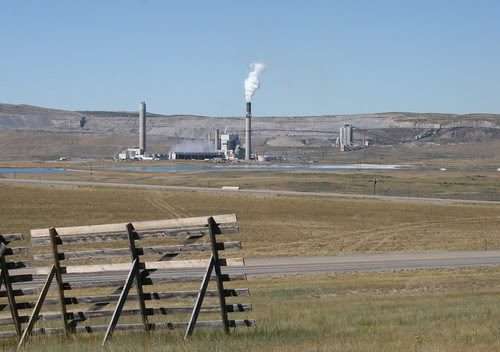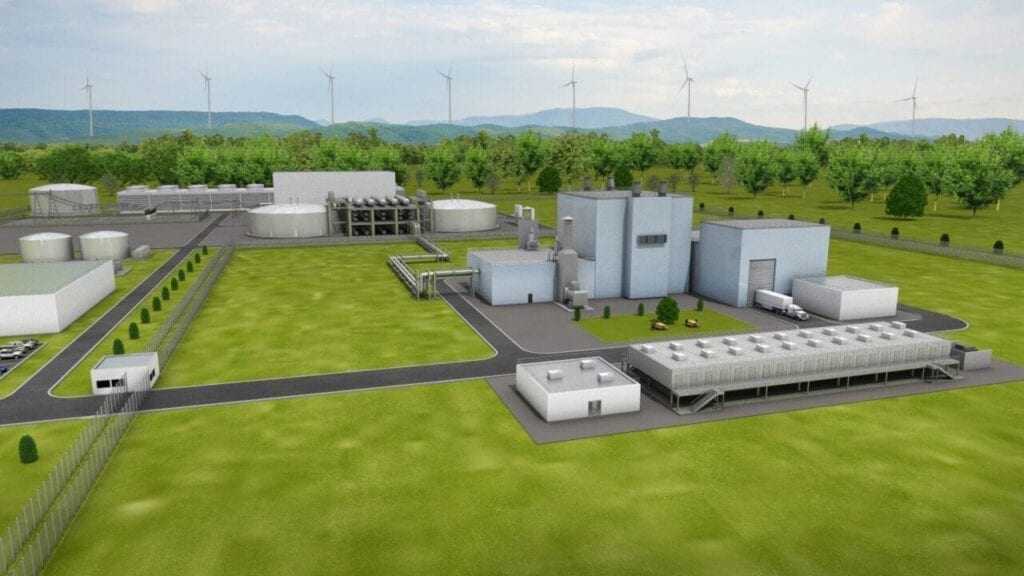Coal Plant Site Unveiled for 500-MW Natrium Advanced Nuclear Pilot
A site at PacifiCorp’s retiring 600-MW coal and gas–fired Naughton Power Plant in Kemmerer, Wyoming, will house the Natrium demonstration, a pioneering commercial-scale 500-MW project that will pair a 345-MW sodium-cooled fast reactor with a molten salt-based energy storage system.
Project stakeholders on Nov. 16 unveiled the site for the federally backed demonstration, which will validate Terrapower and GE-Hitachi’s advanced nuclear technology design, construction, and operation. But the project—which the Natrium consortium will build but Rocky Mountain Power, a subsidiary of Berkshire Hathaway Energy’s PacifiCorp, will own—has also been much-watched because it promises to demonstrate how advanced nuclear can leverage existing infrastructure to replace fossil power and provide regional flexibility.
While the preferred site at the Naughton plant still needs finalized “definitive agreements on the site and applicable permitting, licensing, and support,” stakeholders said they plan to submit the demonstration project’s construction permit application to the Nuclear Regulatory Commission (NRC) in mid-2023. The plant is expected to be operational within the next seven years—by 2028—aligning with the Department of Energy’s (DOE’s) Advanced Reactor Demonstration Program (ARDP) schedule, as mandated by Congress.
“This will be the first [reactor] built, but it will be a commercial asset that will provide at least 60 years of power to people in Wyoming and surrounding regions,” TerraPower President and CEO Chris Levesque told reporters on Tuesday.
Naughton Plant Site Pick Is Strategic
TerraPower and Pacificorp said they chose the Kemmerer site in Lincoln County “following an extensive evaluation process and meetings with community members and leaders.” Other sites considered were the Wyodak plant near Gillette in northeastern Wyoming, the Jim Bridger plant near Rock Springs in southwestern Wyoming, and the Dave Johnston plant near Glenrock in east-central Wyoming. Factors that played to Naughton’s benefit included community support, the physical characteristics of the site, the ability of the site to obtain a license from the NRC, access to existing infrastructure, and the needs of the grid, executives said on Tuesday.
Pacificorp, a regulated utility headquartered in Oregon, currently owns and operates the three power generating units at the Naughton Power Plant, which sprawls over 1,120 acres of remote land in western Wyoming between Wyoming State Highway 189 and the Kemmerer Operations coal mine. The 70-year-old coal mine, which comprises three open-cut pits, supplies subbituminous coal to the plant and other nearby industrial sites.

“There’s quite a bit of land around the Naughton plant, and we’re considering several different plot plans right now fairly close to the Naughton plant,” said Levesque. “We’re still figuring that out. There are quite a few options. We’re trying to optimize things for the best plant layout, best construction access, ease of excavation, ease of transporting some of the equipment that will be delivered to the site.”
Leveraging Existing Transmission
For PacifiCorp, the demonstration would mean revitalizing a productive plant site and leveraging its existing infrastructure to provide much-needed flexibility and reliability to the region. In 2019, as part of a bid to phase out coal-fired generation, Pacificorp announced it would shutter the 1968-completed Naughton 1 and 2, a combined 357 MW, in 2025, four years earlier than planned. Last year, it completed a planned conversion of the 1971-built Naughton 3 coal unit into a 247-MW natural gas–fired peaker facility. However, as the company’s September 2021–issued integrated resource plan (IRP) suggests, the utility plans to retire Naughton 3 at the end of 2029.
“Unit 3 will need to retire when [the demonstration] goes into service for the simple fact that the transmission interconnection capacity for the entire plant, or at least most of Unit 3’s capacity, will be needed to meet the 500 MW that this Natrium plant will need,” Gary Hoogeveen, president and CEO of Rocky Mountain Power, told POWER on Tuesday.
Hoogeveen, however, also highlighted the project’s distinct potential to provide crucial service to the region, which is heavily reliant on intermittent power. “Wyoming is a tremendous wind resource state, and we have built, through Energy Vision 2020, and work before that, 2,000 MW of wind capacity. We expect to build many more thousand megawatts of wind capacity in the state—there’s that much available,” he noted.
“Transmission will continue to need to be built, but the site of this Natrium project in Kemmerer is in the perfect location for grid support,” he said. “It is at a current facility that has interconnection, but it’s between the eastern Wyoming resources that we have, where the wind is, and the major metropolitan areas of the Wasatch Front in Utah. So it’s a great spot for absorbing the intermittency of the renewable resources and using the storage that’s built-in that is so incredibly valuable to us.”
Pioneering a Nuclear-Storage Hybrid
PacifiCorp’s 2021 IRP notably includes modeling for the Natrium demonstration with distinct placement at the Naughton facility. Though it does not reveal specific cost and performance assumptions for the demonstration—citing confidentiality—the IRP suggests the demonstration “promises many benefits” to PacifiCorp.
These include “a 24/7 reliable source of clean energy with embedded storage, safety, cost and reduced spent fuel advantages while providing an employment transition opportunity for our existing coal employees and an economic boost to the community where they reside.” The IRP adds: “Using safety features that take advantage of natural forces and do not require human intervention, this reactor will be able to shut down safely and independently, greatly reducing the risks associated with earlier nuclear reactors.”
As significantly, assuming the Natrium demonstration is fruitful, PacifiCorp’s 2021 IRP “least-cost, least-risk” portfolio—its preferred portfolio—envisions integrating 1,000 MW of “additional advanced nuclear resources” and 1,226 MW of “non-emitting peaking resources” through 2040. The IRP suggests new “non-emitting peaking” capacity could come online in 2033 and 2038. If the Natrium demonstration isn’t included in a future portfolio, one scenario suggests PacifiCorp would consider adding more solar co-located with storage but risk ramping up utilization of its fossil-fueled resources by up to 3%, depending on the price-policy scenario.
The IRP also offers a preliminary glimpse into how Pacificorp envisions the project will operate. Among its “primary elements,” the demonstration will have a nuclear reactor and a steam generator that will together produce 345 MW of baseload energy capacity at a 92.5% capacity factor, it says.
The demonstration will also include a nitrate molten salt energy storage system, which has the potential to boost the system’s output to a maximum 500 MWe and a minimum of 100 MWe for more than five and a half hours when needed, as POWER has previously detailed.
Pacificorp’s IRP suggests the Natrium project may offer a ramp rate of about 40 MW per minute from minimum to maximum. “Molten salt storage supports maximum output of 500 MW for a 5.5-hour duration (max output then drops to 345 MW until output is reduced and more heat can be stored),” it says. “Maximum storage efficiency is 99%.”

TerraPower has said developers went with nitrate molten salt as the storage coolant because it “offers the best combination of non-nuclear industrial properties and compatibility with sodium. Nitrate salts also overlap the Natrium technology’s operating temperatures better than any other competing reactor coolant, and the Natrium system has the best base technology to leverage molten salt-based thermal storage, it said.
Tight Construction Timeframe for First-of-a-Kind Project
Still, how quickly and efficiently developers will be able to put the advanced nuclear demonstration online to meet the 2028 Congressional mandate remains a concern. The DOE’s commitment may prove pivotal as Natrium sets out to meet its tight seven-year schedule under the ARDP. Owing to its first-of-a-kind attributes, the project needs to meet a long list of pioneering milestones as they relate to research, plant design, equipment testing and qualification, and procurement and construction.

On Tuesday, Levesque highlighted cost and timeframe concerns that may hinge on regulatory reviews by the NRC. “One important thing to realize is the first plant always costs more. There’s a first-time design, and there’s a very comprehensive licensing process overseen by the NRC that frankly is expensive,” he said.
Securing an adequate fuel supply could also prove a major challenge. TerraPower, like other advanced nuclear project developers, will be dependent on emerging advanced nuclear fuel development to energize its project, but commercial-scale domestic production capabilities for high-assay, low-enriched uranium (HALEU) have yet to be established.
“Natrium will run on HALEU for the life of the plant,” Levesque noted. “We do expect [future] Natrium plants could be higher power outputs, and as the plant size gets larger for future plants, the enrichment levels should be reduced. So we may not require HALEU for all future plants, but for this first wave of plants that have 345 MW, we picked HALEU,” he said.
For now, the Natrium consortium plans to “work closely” with the Department of Defense to ensure a supply of HALEU for the demonstration, Levesque said. Meanwhile, the Natrium consortium is also teaming with Centrus Energy to establish HALEU supply. TerraPower and partners also plan to invest in a fuel facility to make Natrium fuel for the plant in Kemmerer, Levesque said.
Other necessary first-time supply chain investments may also set the slate for a quicker roll-out of future plants, Levesque said. “Including the plant construction in Kemmerer in Wyoming, first-time design, licensing, and the supply chain investments, it’s about a $4 billion project, which is 50% government grant, 50% private investment,” he noted.
Finally, securing workers with the right skillsets will be a priority. TerraPower on Tuesday projected about 2,000 workers will be needed for construction at the project’s peak. “Once the plant is operational, approximately 250 people will support day-to-day activities, including plant security,” it said.
Infrastructure Act Delivers Big Boost to ARDP Projects
Levesque noted President Biden’s Nov. 15–signed Infrastructure Investment and Jobs Act allocates $2.5 billion in new funding for the ARDP. That allocation, along with previous funding, will cover DOE’s commitment to TerraPower for the first five years of a seven-year, $2 billion agreement. “TerraPower will match this investment dollar for dollar. Federal funding is provided for the demonstration activity under a cost-shared cooperative agreement and the result of the project will be a commercially-owned generating asset,” the company noted.
Alongside the Natrium consortium, Rockville, Maryland–based X-energy won first-round funding under the first ARDP pathway in a tough competition for the federal funding opportunity. X-energy has said it will use the funding to deliver a commercial four-unit power plant based on its Xe-100 reactor design, an 80-MWe/200-MWth pebble-bed high-temperature gas reactor, which can be scaled as a four-pack to 320 MWe, at a site in Washington state in partnership with public-power utility Energy Northwest.
X-energy, notably, will also leverage the ARDP award to deliver a commercial-scale fuel fabrication facility for its proprietary TRISO-X TRi-structural ISOtropic particle fuel (TRISO) technology. The company on Nov. 4 announced it had completed preliminary design for its TRISO-X fuel fabrication facility, marking a key step in its commercialization efforts toward the first-of-a-kind NRC regulated Category II facility capable of handling HALEU.
Commercial operation of the TRISO-X fuel fabrication facility is slated for 2025 and will fuel the Xe-100 plant, which is expected to come online in 2027, X-energy told POWER earlier this month. “[The Office of Nuclear Energy at the DOE] has been a great partner in this cooperative agreement and continues to ensure funding for the project while we continue to meet all project milestones. Our design, licensing, and construction plans are all on track,” the company said.
—Sonal Patel is a POWER senior associate editor (@sonalcpatel, @POWERmagazine).